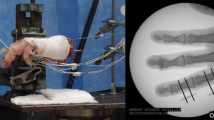Abstract
The goal of this study was to simulate the mechanisms of hyperflexion and hyperextension injuries of the distal interphalangeal (DIP) joint of the hand and to analyze the resulting extensor tendon injury patterns. The hypotheses were raised that hyperflexion trauma leads to a plastic deformation of the extensor tendon aponeurosis, with or without a small bony avulsion fragment but without joint surface involvement, and that hyperextension injuries can create a shear fracture of the dorsal lip of the distal phalanx, without injury to the extensor tendon aponeurosis. Loading was applied with a swinging pendulum impacting the distal phalanx in 103 human specimens in either an extended or flexion position. After loading, injury patterns were analyzed radiologically and histologically. There was evidence that hyperflexion trauma leads to a plastic deformation or rupture of the extensor tendon. Bony tendon avulsion was evident in 12.2 % of cases. With hyperextension, the extensor tendon remained intact in all cases, but there were large fracture fragments involving the articular surface in 4.1 % of cases. The results of the study show that force on the flexed joint leads to overstretching of the extensor tendon, and to an associated dorsal bony avulsion with intact joint line. Force applied to the joint in extension can lead to a bony dorsal edge fracture with articular involvement and with it, a palmar DIP joint capsule rupture. The results illuminate a direct correlation between the mechanism of injury and the pattern of injury in the clinical picture of mallet finger.




Similar content being viewed by others
References
Alla SR, Deal ND, Dempsey IJ (2014) Current concepts: mallet finger. Hand 9(2):138–144
Blair WF, Steyers CM (1992) Extensor tendon injuries. Orthop Clin North Am 23:141–148
Cheung JPV, Fung B, Ip WY (2012) Review on mallet finger treatment. Hand Surg 17(3):439–447
Doyle JR (1999) Extensor tendons—acute injuries. In: Green DP, Hotchkiss RN, Pederson WC (eds) Green operative hand surgery, 4th edn. Churchill Livingstone, Philadelphia, pp 1962–1971
Evans RB, Burkhalter WE (1986) A study of the dynamic anatomy of extensor tendons and implications for treatment. J Hand Surg [Am] 11:774–779
Hallberg D, Lindholm A (1960) Subcutaneous rupture of the extensor tendon of the distal phalanx of the finger: “mallet finger”—brief review of the literature and report on 127 cases treated conservatively. Acta Chir Scand 119:260–267
Hoch J, Fritsch H, Frenz C (1999) Does avulsion fracture of the finger extensor tendon really exist? Plastination histological studies on the insertion of the dorsal extension plate and its consequences for hand surgery. Chirurg 70(6):705–712
Lange RH, Engber WD (1983) Hyperextension mallet finger. Orthopedics 6(11):1426–1431
Rockwell WB, Butler PN, Byrne BA (2000) Extensor Tendon: anatomy, injury, and reconstruction. Plast Reconstr Surg 106(7):1592–1603
Stark HH, Boyes JH, Wilson JN (1962) Mallet finger. J Bone Joint Surg Am 44(6):1061–1068
Verdan CE (1966) Primary and secondary repair of flexor and extensor tendon injuries. In: Flynn JE (ed) Hand surgery. Williams & Wilkins, Baltimore, p 220
Watts AC, Hooper G (2004) Extensor tendon injuries in the hand. Curr Orthop 18:477–483
Wehbé MA, Schneider LH (1984) Mallet fractures. J Bone Joint Surg Am 66(5):658–669
Acknowledgments
The authors would like to express their gratitude in silent prayer to Prof. Dr. Juergen Koebke for his kind support in this study. The authors thank Mrs. Jutta Knifka for her technical support in the preparation of the histological specimens.
Author information
Authors and Affiliations
Corresponding author
Ethics declarations
Conflict of interest
The authors declare that they have no conflict of interest.
Rights and permissions
About this article
Cite this article
Kreuder, A., Pennig, D., Boese, C.K. et al. Mallet finger: a simulation and analysis of hyperflexion versus hyperextension injuries. Surg Radiol Anat 38, 403–407 (2016). https://doi.org/10.1007/s00276-015-1577-6
Received:
Accepted:
Published:
Issue Date:
DOI: https://doi.org/10.1007/s00276-015-1577-6




